Problem Statement
Introduction
This dissertation critically illustrates the perceptions and attitudes of the rules of multinationals to comply with corporate governance system that govern the business organizations in Vietnam and factors touching their motivation and exploration within the existing rules where Nike is a case study.
The legislation those issued by the National Assembly of Vietnam to administering the commercial concerns, to what extend Nike comply with them- is the major focus of this dissertational effort. Vietnam has no single law for corporate governance but there is a number of legislation those all together integrated most of the world class provisions comparable with European Law, and US but there is enough debate with corporate governance practice by the multinationals. It has also evidenced that the US multinational like Nike has failed to establish any sustainable standard of their operation to deliver appropriate corporate governance system, this dissertation would investigate with such dilemmas of corporate governance practice in Vietnam.
Background of the problem
Cung (2008) pointed out that Vietnam has gained significant progress to developing it corporate governance legislations as a whole while the World Bank (2006) urged for reconfiguring the corporate governance structure with long recommendations. Vietnam is the global heavenly place for the multinationals for it paradigm shift and geographic location and a huge number of European and American multinationals. Some of them have already aligned with different corporate scandal though the governmental policy continuously supporting the multinational for their FDI contribution.
Davis and Dzung (2010) mentioned that in the area of voluntary exposes of the listed companies in Vietnam linking their uniqueness, economy, and political sustainability in the HOSE (Ho Chi Minh City Stock Exchange) and HaSTC (Hanoi Securities Trading Centre) and the and argued that the size and age of firm, debt-ratio, and profitability, criteria of ownership are the major factors that influence the voluntary disclosure of the companies. This study also drooped out to examining the historical and critical school of thinking that pointed to the factors those play vital role in the corporate governance practice.
Within this above scenario, the governing rules of corporate governance system in Vietnam has been passing through an unstable situation facing different changes, and generating huge complicated situation regarding to corporate managers, and the regulators while the management suffered from risk of volatility and the shareholder’s interests are not safeguarded. With this background problem, this researcher has decided to conduct a study with the emergence measuring the corporate governance multinationals working in Vietnam and considered that such a research would determine the way out for the regulators of Vietnam to coming out from the existing dilemmas and the develop a suitable solution.
Rationale for the research
Many scholars tried to find out the solution of the question to what extend corporate governance of Vietnam has progressed, some of them investigated how multinational maintain their corporate governance in Vietnam but no research agenda has been raised how multinationals practice corporate governance in Vietnam. Most of the remarkable contemporary researchers have concentrated on the corporate governance standards, and regulatory reform in Vietnam but no overarching research agenda has yet been proposed on the non-compliance of CG system by the multinational in Vietnam.
The rationale of this research is to analyze the rules that govern corporate system in Vietnam experience by observing the real scenario of multinational such as Nike. In addition, the corporate fraud of Enron and WorldCom has escalated the awareness of regulators to take control over the corporate governance system, while the global financial crisis already socked the Stock Market of Vietnam and the policy makers are anxious to bring back the investor’s confidence. This dissertation has aimed to assist the academia, regulators, policy makers, and investors with better understanding about the lacking of corporate governance practice by multinational like Nike.
Research Question and Objectives
There are so may research already conducted with the nature and scope of corporate governance standard and practice in Vietnam, but there is no research agenda has been raised with the historical complexities of corporate governance standards and practice of multinational in Vietnam, this research ahs aimed to address these gaps. This dissertation aimed to investigate; to what extent the multinationals comply with corporate governance practice where Nike in Vietnam is a case study and to do so, this research has grounded with following research questions-
- To what extent is the theoretical framework of corporate governance encouraged and developed in Vietnam?
- How the local legislation would safeguard governance in Vietnam related to those in developed countries like the USA and the UK?
- What are the barriers preventing the Multinationals in general and Nike in particular from complying with corporate governance practice in Vietnam?
Relevant Literature Review
Theoretical framework of Corporate Governance
Corporate Governance
The concept of CG has developed in order to manage or control the internal system of the corporations by setting large numbers of rules and code of conduct (Oman, Fries & Buiter, 2003). However, Lowry and Dignam (2007, p.404) pointed out the importance of CG and stated that effective internal controlling mechanisms ensure the right of shareholders, minimize corporate risks, control the organizational activities with excellent business confidence, maximize corporate performance, and protect the interests of investors. OECD (2004) observed that the risk of the company due to lack of accountability of top management, therefore, this organization provided a set of fundamental principles those have already considered as a guideline of the CG system in most of the country. According to the fundamental principles of OECD, CG system of any country should design considering three main features such as guidance to ease and inspire the performance of corporations, rules to limit insiders’ abuse of power over corporate resources and the means to monitor managers’ behavior.
Influential factors to develop Corporate Governance
Oman, Fries & Buiter (2003) stated that CG system is more important for listed companies those raise capital from stock market because investors show interest to invest in well-governed companies to avoid any financial risks. However, Monks & Minow (2007) identified that the investors take into consideration the effective CG system because investors experienced the biggest corporate scandals of accounts from the beginning of the 21st century. However, the CG system in developing has not structured in accordance with international standard, as most of the companies have no presence in national stock exchange. At the same time, the policy makers of these countries have no headache to improve such position due to lack of companies with widely traded shares (Oman, Fries & Buiter, 2003).
In addition, they further addressed that the government of developing countries belong wrong conception and give no importance though this is one of the most challenging issues in emerging economy. On the other hand, the corporations of these zones have not experienced success in global market, as investors have no confidence on the companies’ internal controlling system. On the other hand, the policy makers of developed countries always restructure CG system considering the external and internal factors in financial market, for instance, the US government reshaped their listing rules by enacting Sarbanes-Oxley Act 2002 because Enron, Worldcom, Tyco and HealthSouth had collapsed at the beginning of the new millennium due to corporate governance failure. As a result, Abeysekera (2003) stated the importance of political and economical impact on the company and the CG system; however, Tinker (1980) also provided Political Economy of Accounting (PEA) framework to advance the financial reporting system.
The Principles of Governance
Trinh (2010) has considered the report of OECD and pointed out the rights of shareholders, the equitable treatment of shareholders, the role of stakeholders, Disclosure and transparency, the responsibilities of the board and many other issues in the literature review of the dissertation. On the other hand, Aras & Crowther (2008) has also researched on the global perspective of CG where he notified seven major stages of CG including the major analysis of OECD report. Therefore, the literature review of this dissertation would observe the key points of the principle of CG considering the report of OECD, Trinh, Aras & Crowther and other renowned researcher.
- Shareholders’ rights and equitable treatment: According to the view of Trinh (2010) and OECD (2004), the right of the shareholders based on some criteria like fair and equal treatment, decision-making power, voting rights, legitimate expectation and some other related issues. At the same time, OECD (2004) noted that CG frameworks should guarantee the equitable treatment of all shareholders and OECD (2004) addressed that they should have scope to get effective remedy for violation of their rights to ensure equality. In this case, Lowry and Dignam (2007) addressed the decision of the case Foss vs. Harbottle (1843) the issue of shareholders’ rights have always been very complex and difficult to understand the scenario while the company control in accordance with the Article of association and memorandum. Therefore, the court was not intended to interfere in case of internal management system as they thought majority members should control the company as they are supposedly more commercially aware than judges but now most of the developed countries made laws to protect shareholders right particularly the minority shareholder’s right (Lowry and Dignam, 2007) and (Gower & Davies, 2007). However, Gompers, Ishii, and Metrick (2003) categorized twenty-four governance factors into five groups relying on the IRRC data to give safeguard to the shareholders.
- The stakeholders’ role: Most of the previous research on CG system of emerging economy including OECD highlighted the issue of stakeholders’ role to control or manage the company. However, the UK Companies Act 2006 has incorporated directors’ duties in section 170 to section 177 to impose statutory duty to the directors, which direct them to act within powers and to act in good faith, to exercise independent judgment, to avoid conflicts of interest and to exercise reasonable care, skill and diligence (Chivers, 2007). In this case, the provisions of CA 2006 reflect the recommended provisions of OECD, which help the judicial body to take action in accordance with the noncompliance of the rule. Therefore, the CG system of emerging economy should classify the stakeholders’ role according the OECD report;
- Disclosure and transparency: Aras & Crowther (2008) stated that the information regarding the decision of the board of directors could influence the stakeholders and shareholders both positively and negatively. Thus, the accurate information should available easily because the outsiders mainly rely on the insiders’ report such as bank and other investors rely on the financial reports of the company where transparency play vital role.
- The responsibilities of the board: According to the report of OECD (2004), selecting the chief executive officer and monitoring the performance of CEO is the most important task of the board of directors. However, Lowry and Dignam (2007) stated that the prominent duty of the board is to select independent non-executive officers who would be responsible to control remuneration policy of the company as
Development of Corporate Governance Vietnam
Historical development of Corporate Governance Vietnam
Hai (2006) pointed out that the company law, corporate governance of Vietnam has long routed from the Central Vietnam Commercial Code 1942 of French due to its colonial rule up to 1945, and later on independence, the prevailing company law sustained for nest to decades due to Geneva Accords, dividing the country into two parts and concerned Vietnam War. The concerned legislation has modified with Commercial Code 1972 that managed the governance structure of the Vietnamese companies with four structures such as (i) partnership association, ii) General share capital organization, iii) Joint capital organization, iv) limited liability association (LLA).
The corporate governance regime under the Commercial Code 1972 modeled that few managers who may be a shareholder or not would administer the limited liability organizations of Vietnam, it is compulsory to keep a supervisory board of three members from the shareholders while there are more than twenty members. For the General shareholding companies they also could administer with managers and supervised with a management board, where it would contain an elected chairperson who also treated as MD (Managing Director). Due to the political polarization and reunification of south and North Vietnam under the leadership of the Communist Party of Vietnam, company code of 1972 was abolished in 1975. CPV (Communist Party of Vietnam) reconstructed the company law with the ideology of socialist economy that was completely opposite to the open economy of capitalism and core essence of globalization and the controlling sustained up to 1990.
During the decade from 1975 to 1990, there was no corporate governance system in Vietnam as there were no private properties and all the commercial concerns were owned by the sate and controlled by the centrally planned economy of socialism, within this period 1500 private companies with 130000 workers were nationalized. In 1986, CPV aimed to economic reformation by practicing market economy with liberalization and nourishing the private enterprises. Such drives of CPV had enhanced the growth of private sector, and it was emergence towards constitutional reformation of 1992 with multi-sector market economy. With the aim to open the Vietnamese market to the global capitalism and to welcome the multinationals such as China model, Vietnam constructed the “Law on Foreign Investment” – 1987, the Companies Law – 1990, and the Law on Private Enterprises – 1990 , where the governance structure pointed to the form of limited liability company and shareholding company (Hai, 2006)..Moreover the Enterprise Law – 1999 and the new Enterprise Law – 2005 has facilitated the Vietnamese corporate governance structure almost similar to the Commercial Code 1972 connecting with the colonial corporate structure that prevailed in the country during French rule.
Legislative Reformation for Corporate Governance Vietnam
Minh (2006) argued that the Vietnamese legislation has aimed to liberate the corporate governance system by introducing more new legislative changes incusing the Law on Investment – 2005, and the Law on Enterprises – 2005 while Law on Foreign Investment – 1987, the Companies Law – 1990, and the Law on Private Enterprises – 1990, and Enterprise Law – 1999 are also in practice. Moreover, the Vietnamese labor code 1994 and 2007 has also provided enhanced guidance for ethical conduct of corporate governance in the country. In fact all the above legislations all together generate the corporate governance system of Vietnam, thus to understand and study the CG system of Vietnam, it is essential to learn the core essence of the prevailing laws.
Law on Enterprises – 2005
This legislation has provided the opportunity for direct investment in Vietnam by foreign nations through creating entirely foreigners owned companies by forming joint venture with local investors while the BCC (Business Cooperation Contract), BOT (Build-Operate-Transfer), and BT (Build-Transfer) are different form of amalgamation for local companies with the multinationals while share capital contribution or merger and acquisition could take place. The Law on Enterprise – 2005 has provided a harmonized framework for the local and overseas companies for FDI through registering under this act or companies registered under law on cooperatives while the governance system of this act permitted to convey limited liability entry, joint stock registered company, partnership, and holding company.
Minh (2006) added that under this new legislation for companies of necessitate to have at least 65% votes for any decision making regarding the charter of the company while for investment decision or half of asset selling it has kept provision to have at least 75% of the board of directors concern. Same voting provision has kept for the companies registered under Joint Stock Company while the Law on Foreign Investment all matters of JVE (Joint Venture Enterprise) has provided that 51% of the board members voting could uphold any decision of the company those may not conflict within existing practice.
Charter of the Company under Law on Enterprises – 2005
National Assembly (2005) pointed out that the Article – 22 of the Law on Enterprises – 2005 has grounded with the core contents of the company charter, at time of registration all the entrepreneurs have to provide all necessary information of them along with the prospective business that the company would like to conduct, capital structure, and contribution of the shareholders. It is obligatory to mention the rights and obligations of shareholders, or members, their management and organizational structure, legal representative, internal dispute resolution method, process of calculating remuneration and wages of the management and employees, distribution of profit, loose and tax, liquidation process would also integrated in the charter of the company. The charter of the company also kept the scope to amending any bylaw that the board of directors would consider to amend at the any stage of business operation, redeem its share of capital, audit process and the power, functions and tasks of each member.
Vietnamese Labor Code -2002
The National Assembly (2003) pointed out that the government of Vietnam considered labor as the vital function of human race to generate productive force for goods and services with social values while excellence and effectiveness of Vietnamese workforce is the noteworthy factors for the national economic growth. Vietnamese Labor Code -2002 contributes the nation through emphasizing the rights and obligations of working class with ethical labor standards, appropriate exploitation and management of labor and all the business entries in the territory of Vietnam are obliged strictly maintain the principles of this law, no foreign or domestic companies would not get any exemption to follow this law.
The Labor Code of Vietnam has played a significant role within the society along with the legal system of the country while the legislation has inherited from the labor laws of communist revolution of 1945 with the viewpoint of Marxist philosophy and modified by the CPV in 1992 under constitutional reformation, meanwhile the law has also amended in 2002. This legislation has ensured that all citizens of Vietnam within its geographic region would enjoy equal rights of selecting their working area with freedom of gaining skills and changing their job where the corporation whether it is state owned, foreign entry or domestic entrepreneur may not discriminate the workers for social classes, race, or gender.
The Labor Code of Vietnam 2002 has sticky restricted child labor by defining the employee as an individual of minimum fifteen years of old and capable to perform physical labor by coming in to agreement with the employer while the employees are entitled to get higher or equivalent wage of the government predetermined wages. Employees are also allowed to get social security, heath, insurance, rest, holidays while the female employees would be privileged for special care with healthy workplace environment. The most influential norms under the legislation is the rights of joining in the trade union without any hindrance and the unions are entitled to practice collective bargaining and can go for stick to uphold workers rights while the sate privileged employees rather than employers. Vietnamese citizen has the rights to work freely with their own choice and facilitated to gain skills within the territory of Vietnam without discrimination of race, color, class or regions, where sate, foreign and domestic companies would conduct ethical behave in accordance with this legislation.
Comparison of CG in Vietnam with UK and Europe
Minh and Walker (2008) mentioned that the chronological progress of the legislative framework of CG in Vietnam has landed by the Doi Moi guiding principle with the core essence of the multi sectored market economy in state of centrally controlled socialist economy by ensuring rights of business freedom has come in to implication with the Constitution 1992. Most remarkably, the constitutional reformation has dastardly replaced the Company Law 1990 and explored the way of practicing corporate governance system. In relation to the UK, USA and other European countries the CG system of Vietnam is very younger, but the improvement is noteworthy among the Asian emerging market. In fact, the Enterprises Law – 1999 has endorsed the opportunity to materialize and integrate excellent governance system for Vietnamese companies by replacing the Company Law – 1990 along with the Private Enterprise Law – 1990 more progressively imploring corporate governance system from European and American jurisdictions. Consequently, it has restructured the previous company statutes and facilitated the configuration of a variety of business organizations such as company with limited liability, company with shareholders, and partnering organization.
It has been evidenced that the LLC (Limited Liability Company) in accordance with the Law on Enterprises – 2005 is almost similar to the UK company structure. In general, an LLC under the Enterprises Law 2005 is comparable the Company Law 2006 of United Kingdom, Corporations Act – 2001 of German and US Sarbanes-Oxley Act 2002. Within scope of this legal framework, a business organization would be considered as a separate legal entity; while the maximum number of the members may not exceed 50 whose liabilities are inadequate within the their personal contribution to the share capital of the company and such form of companies has no rights to issue shares to the public. The management of the LLC would consist of Member’s Council including all the shareholders, a chairperson, and a General Director elected by the members vote, and a Control; Board which has demonstrated in the following diagram-
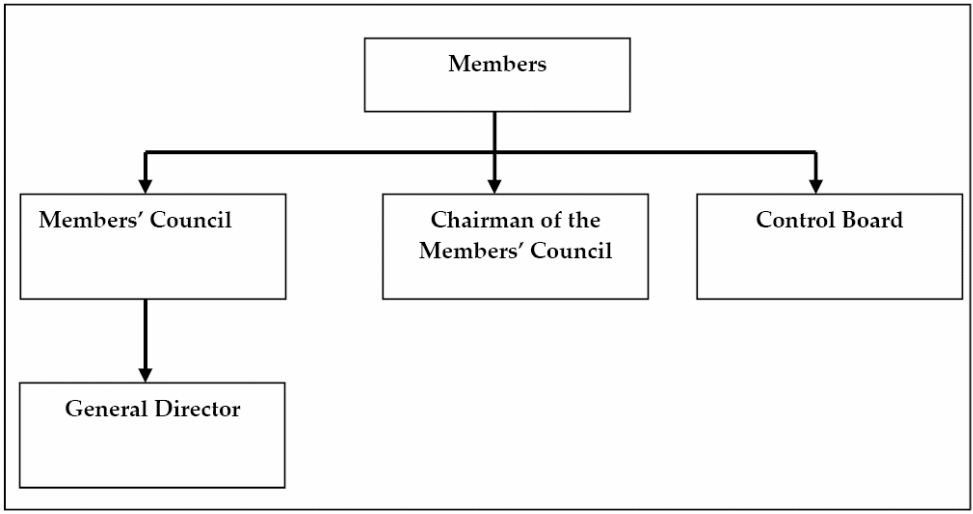
The Vietnamese shareholding companies likewise to the UK, German, and China while the SC (Shareholding Companies) in Vietnam has pleasured, as a separate entry with at least three members, there is scope to allocate share capital equally among the members and allowed to issue public shares with the aim to collect share capital for the stock markets. The management structure of SC (Shareholding Company) formed with GMS involving all shareholders, a board of directors and a general director along with a chairperson, at the same time boards of directors are entitled to conduct time-to-time decision making and appoint a CEO while the board consist of eleven members.
Multinational’s Corporate Governance and Vietnam
FDI Inflow in Vietnam and the Multinationals
Undén (2007) mentioned that in eighties Vietnam has conveyed economic reforms through its Doi Moi policy with the aim to gain economic emancipation from the centrally planned system to the free market economy while the intention lead the county to be an integral part of the global economy. The major rote to such reformation has aligned to gaining Foreign Direct Investment in the country by liberalizing trade barriers, and opening the door of Vietnamese market for Multinational. Vietnam has long been suffering from scarcity of FDI in flow and its development initiatives were hampered due to lack of FDI, while the Multinational were eager to get entry in the Vietnamese market, the policy reformation has matched the both party’s objectives and Multinationals entered in Vietnam. Consequently, Vietnam gained an uninterrupted in flow of FDI that heads the country to gaining 8% GDP growth up to 2010 and turned into a midlevel per capita country. To welcome FDI inflow in the country the government has introduced the Law of Foreign Investment -1987 and from the implication of this law it has amended for at least fourteen new legislation which demonstrate the continuous pressure of Multinational’s entry in Vietnam and governments eagerness to FDI. The FDI inflow continues and reached at pick in 1996 and then reduced due to Asian Financial crisis, the FDI figures has demonstrated as bellow-
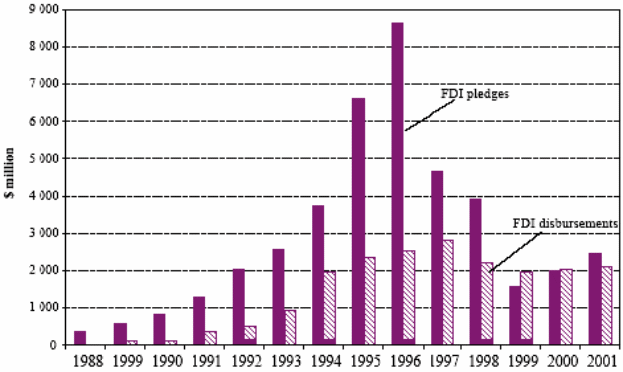
The FDI inflow in Vietnam has played an important function in the economic progress by formulating capital, importing technologies, gaining management skills and exchanging views and options with the developed countries. Open market policy has invited enhanced numbers of multinationals while the cheapest labor cost in Vietnam was a major motivation for the multinationals to enter in this market. Within the drive, most of the large Multinationals have faced towards Vietnam and the government tried to jump towards full range of market economy while the drive hampered due to the policy maters including higher dependence on legislative framework, investments on the infrastructural development and easy access of new organization. The most significant issue is the governance structure for the multinationals who hardly emphasis on corporate social responsibility as propagation but less interested with the compliance of corporate governance system.
Multinational’s Strategy Vietnam
Nguyen et al (2010) argued that the Multinational’s strategy in Vietnam demonstrates that their interest is to utilize the Vietnamese resources as an export platform through foreign direct investment where the vital motivation of the MNCs (Multinationals) is to engage the low cost labor of Vietnam and export the final goods to the home country or to the existing developed markets. Continuous flow of low cost labor, geographic location, market volume, and local transportation cost, regional collaboration, and free trade zone of ASEAN are the major attraction for the MNCs to shift their production facilities in Vietnam while they are in high pressure in the home countries for their environmental degradation. Shifting the factories of MNCs in Vietnam is another strategy of shifting the burden of environment hazards from the home country.
The most common but influential strategy of the MNCs in underdeveloped countries is to bargain and influence the governments with Foreign direct investment, while the FDI motivation adopted to as entry strategy and later this investment strategy used to bargain with the government for their favorable legislative reformation, there is exception to implication of this strategy in case of Vietnam. For both the European and American MNCs approach in Vietnam has identified as an export platform EPFDI (Export Platform Foreign Direct Investment) that is a strategic means to enjoy tax-free entry in the ASEAN market, though their primary intention is to export the final goods to the home country and to the third counties.
Blomstrxom and Kokko (1998) presented the spillover strategy of multinationals arguing that the location where the existence and activities of MNCs increase their scientific along with productive know how for the benefits of their operation in the host country that necessitates to share with the domestic companies. Whether the domestic companies would be gainer or looser from this spillover depends on the socio economic characteristics of the host country, different study demonstrates that mid level economy has the higher success rate in this drive. However, the MNCs argue for the improvement of the domestic companies but they are not interested to improve the domestic companies in a higher stage where they can account themselves as a competitor to the MNCs. Consequently, MNCs continue to keep control over the domestic companies of the host countries and create pressure for hard work rather than technological skills development. On the Other hand, the host countries have to spend a significant part of FDI to import multinational’s suggestive technology while the less control over the foreign exchange accelerate foreign currency outflow by the MNCs as their profit from the export earnings.
Undén (2007) pointed out that most of the MNCs strategy in Vietnam is to operate their business by setting up a representative office in Vietnam without integrating themselves with the productive process or operational flow. The representative office that they set up in Vietnam would organize as a 100 % foreign owned company but do no conduct any factory or production facilities at own registered name. MNCs strategy in Vietnam is to organize wide-ranging supple chain as well as quite a lot of sub-contractors who would take the labiality of produce and the scandals of unethical production means but the function of export and the incentives for export would take into own account.
Motivation of Nike to Complying Corporate Governance in Vietnam
Central Corporate governance of Nike Inc
Nike (2010) pointed out that the company was formed in 1968 under the US legislation of the state of Oregon deals with branded footwear and apparel with the global operation almost one hundred and seventy countries with factories both in home and abroad. Nike (2011) mentioned that the company slickly follows the corporate governance guideline organized by the board of directors and all the concerned persons exercise their responsibilities from to management to the lower level with the aim to creating enhanced shareholders vale.
The Board of the Nike Inc consists of ten to fourteen members elected by shareholders, while the board is the highest forum for decision making, conduct different strategy and appointing officials by keeping highest priority to the owner’s interest. The board is responsible to measuring the performance, foreign operational strategy and rewording policy with ethical operation. There is one CEO appointed from the senior members who represent the company in different forums while the directors are accepted to consult with CEO for their effort essential to assets discharge and their responsibilities including long run strategic business plans to enhance regular activities. The Chairperson is another important position who also elected by the board of detectors. At Nike’s operation the directors are independent for their function they their selection process depends on the decision of the board of directors. Rather than the board of directors the company has a supervisory committee for corporate governance that plays regulatory function with the compliance. The company is listed in the New York Stock exchange and publishes its disclosures publicly complying with the US listing rules while the company follows the Sarbanes–Oxley Act of 2002 to ensure its accountability and transparency.
Corporate Governance of Nike Suppliers in Different Countries
Locke et al (2006) mentioned that the Harvard University has conducted a study with the data from eight hundred factories of Nike Inc in fifty-one countries and identified a very alarming situation with the corporate governance practice including their labor standards. It has evidenced that in most of the Nike factories there are serious lacking to the compliance with the standard of corporate codes of conduct in scale of local legislation or international criteria. Due to the protest form the NGOs (Non-Governmental Organizations) working with labor rights, the violation of labor rights and unethical conducts come into the pubic vision but the violation of corporate governance system do not come into debate. Moreover, the governments of the host countries motivated with FDI inflow do not make any sound against Nike.
It is very curtail to address the poor compliance of Nike’s corporate code of conduct while the effectiveness of Its overseas strategy has failed to ensure healthy workplace situation at its global supply chain specially factories those are continuing production under their on own monitoring and supervision. In the countries where Nike maintain it representative office as a 100% foreign owned company, just emphasis only with quality and quick production without looking towards the improvement of working conditions or globally recognized labor rights. The evidence presented by Locke et al (2006) has argued that in spite of the major efforts for production and venture by Nike, the company is almost reluctant to improving the corporate code of conduct among its subcontractors and factories, while the research argues that the monitoring and supervisory role has delivered very poor results due to non-compliance of corporate governance in the host countries.
Nike’s Corporate Governance in Vietnam
Parker et al (2006) stated that among the MNCs in Vietnam, Nike is the significant contributor to the Vietnamese economy while the company purchases 22% of global needs from Vietnam, in 2001it purchased US$ 450 million from Vietnam which was US$ 728 million in 2004 by creating at least 130,000 job opportunities for the nation. Although Nike is a noteworthy contributor for the economy of Vietnam, it is essential for the government and academia to evaluate to what extend Nike complies with corporate governance system in Vietnam.
ACCV (2010) explored that the US multinational footwear and apparel giant Nike Inc has registered in Vietnam as a 100% foreign company with the name ‘Nike Vietnam LLC’ and it has set up a representative office in Ho Chi Minh City, Vietnam where the company has a General Manager who act as the chief representative and manager for external affairs. So far data available, it has evidenced that that Nike Vietnam LLC has documented with three directors, where the first one is director government affairs, second one is director for apparel operations and the third one director for product operations. The company Nike Vietnam LLC has resisted in Vietnam under the Law on Entrepreneurs– 2005, this legislation directed that the limited labiality companies are under mandatory obligation to have a board of director while the management of LLC would consist of Member’s Council including all the shareholders, a chairperson, and a General Director elected by the members vote. This provision is the primary condition of the corporate governance system in Vietnam for limited labiality companies and it has evidenced that Nike Vietnam LLC has been violating this provision for more than an era.
Under Article – 8 and 9 of Law on Entrepreneurs– 2005 it has clearly mentioned that the employees and worker may not be discriminated connecting their race, class and gender and the workers also have the rights to joining in the union activities. Moreover, it has directed that that the companies would sticky follow the Vietnamese Labor Code -2002. Nguyen (2004) evidenced how the foreign supervisors of Nike Vietnam LLC humiliate the female workers and conduct sexual bondage with women in Nike Factories. It has also witnessed the labor exploitation, human right violation and physical punishment imposed at Nike factories in Vietnam. Locker et al (2007) presented the eyewitness of violating corporate code of conduct including Vietnamese Labor Code -2002.at the Nike factories through their subcontractors. Bhatnagar and Rathore (2006) identified very specific factories that do not bother for corporate code of conduct and conduct brutal behavior with the employees. Thus Nike in Vietnam has failed to comply with Article – 8 and 9 of Law on Entrepreneurs– 2005
Under Article – 10 and 12 of Law on Entrepreneurs– 2005 has directed that the companies would maintain cost accounting, Books of accounts, accounting records, and publish annual financial statements for both regulatory authority and for the public, but there is no evidence of Nike Vietnam LLC to maintain this discloser guideline. Boje (2008) pointed out that the documentation of code of conduct that Nike represents to the media and public is just trickery facade rather than real face for its global operation in most of the factories. At the agreements with contractors, Nike emphasis on cost effectiveness rather than ethical conduct of corporate governance and never highlighting regarding the necessity of workers union and it is also interested to perform its business with the factories those appreciate and identify such workers rights and illegitimately obstruct the employee’s permissible actions to put into effect of those rights. In the home country, the corporate governance connecting with corporate social responsibilities of Nike has maintained ethical standards but in the host countries, the compliance CG and CSR is very lower standard and may not comply with home county standards.
Most of the governments and ILO (International Labor Organization) jointly acknowledged the privileges of the independence of workers union and rights of their collective bargaining but the factories of Nike in Vietnam, China, and Thailand do not comply with labor law of the concerned countries or international standard. In fact, the effective corporate governance is interlinked with the good will of companies, union, and the government while the local legislation has the greater opportunity to make them bound to comply with the labor law. Boje (2008) also evidenced that there was a website named nikeworkers.com, where Nike employees presented their views and exchanged their options, in the name of media content management Nike has removed all those workers views and closed that website.
Methodology
Introduction
The main aim of the third chapter is to choice an appropriate research approach to express how the preferred research method will match with the key objectives of the dissertational investigation, the purpose of the study to understand the emergence and development of the rules that govern corporate system in Vietnam by adopting the methodological framework of Malhotra (2009). Therefore, this research methodology would keep significant role to get a clear idea how the selected approach practically implemented in the current study of the CG of Vietnam.
Research Approach
Malhotra (2009) and Saunders et al (2006) recommended that there are in general two research approaches, theses are qualitative and quantitative approach, the present dissertation will engage with quantitative research approach as it leads to quantify the data, thus naturally it adopts different types of statistical analysis. At the same time, this dissertation would make use of Microsoft excel to quantify data and to graphically represent collected primary data. On the other hand, the methodology chapter would elaborately argue regarding the primary data collection procedure, interview method, target respondents, primary data analysis process, questionnaire designing progression, importance of questionnaire, number of respondents, data collection process and so on.
Secondary Data Source
According to the research approach of Saunders, Thornhill & Lewis (2006) and Zikmund (2006), secondary data sources is more reliable and valuable than primary data because it is processed data, which acknowledged by the renowned universities and publishers. However, the significance of use such data is less time requirement with less expense while primary data collection is a lengthy process. As a result, this paper consider number of secondary resources including journal article, management books, annual reports, law reports, official documents, unofficial documents and other publications relating with the topic and Nike case study. However, the key secondary reports are Nike’s Corporate Governance Guidelines, World Bank’s report on Corporate Governance Country Assessment Vietnam, Annual report 2010 of Nike, Locker’s beyond corporate codes of conduct, Nguyen’s article on Nike in Vietnam: an eyewitness account, Labor Code of Socialist Republic of Vietnam, and many other related report.
Primary research
According to the view of Zikmund (2006) and Malhotra (2009), this type of data concentrates on the specific research dilemma. Cohen, Manion & Morrison (2007) provided the key advantages of primary data by stating that it should collect primary data to identify research gap and remove research dilemma in many case though it is time-consuming factor. The author of this study will use this data because the history of the development of corporate governance in Vietnam and the performance of the companies can be obtained from available published secondary reports, but such information can not give clear perception of corporate governance practice for its operation in this country.
Sample
As corporate governance is a complicated issue to the general people and the employees, the researcher will top management of Nike’s 42 sub-contractors in Vietnam for the data collection. In addition, the researcher will not consider large number of sample group due to unavailability of the senior managements and lack of sufficient time and funds. However, the subsequent table demonstrates more details of the target respondents –
Table 3: Selected respondents for interview. Source: Self generated.
Questionnaire Design
Sekaran (2006) stated that questionnaire is a preformulated written set of questions and effective data collection mechanism to research on particular area. However, it is one of the most significant factors because final two chapters of this dissertation will completely be based on the response of the target respondents. Malhotra (2009, p.281) stated that there is no specific rule to formulate questionnaire but the researcher should concentrate on few points like the research objectives and questions, data collection procedure, communication skills of respondents, content of the questions, and many other related factors. However, the subsequent figure point outs ten significant factors-
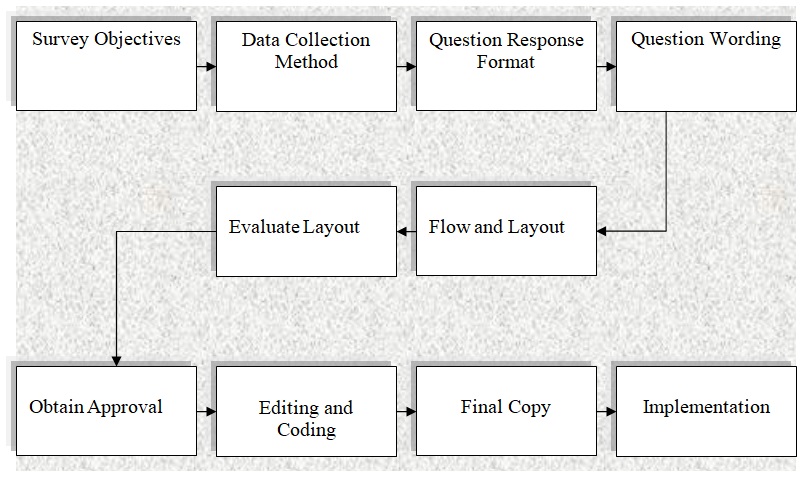
Table 2: Content of the questionnaire. Source: Self generated.
Data Collection process
After preparing the questionnaire, it is important to select a proper data collection process by comparing the advantages and disadvantages of several data collection method. However, it is also necessary to consider the number of respondents, location of the selected respondents and available deadline for the completion of the survey. Sekaran (2006) and Malhotra (2009) pointed out face-to-face interview is the most effective process for data collection while the survey is confined to a local area or single place. They further added that this interview method is effective because it can collect within very short period with less expense while other method incur huge costs and provide fabricated answer. In this paper, the selected top management from Nike’s 42 sub-contractors in Vietnam are living different area of Vietnam, so, application of more instantaneous method like e-mail, telephone and other computer based system instead of face-to-face interview.
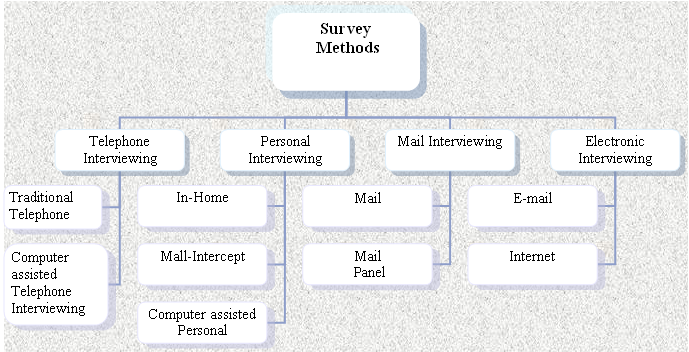
Data analysis method
At the first step of data analysis, the researcher will rechecked and examined the collected data with the aim to remove unintentional error to analyze the data in the findings chapter. Later on, the researcher of this study would scrutinize the responses, as some respondents may not fill out all the questions, after categorizing into apposite groups, editing, and coding complete survey forms, data would be presented graphically in the finding chapter with correct results of the research.
Limitations of the data collection
The major difficulties of data collection process were
- This dissertation consider top level management for interview because the concept of CG is the complex issue to understand for the employees and the ordinary staff of Nike have no idea of implementation process and non-compliance of CG. However, top level management of Nike in Vietnam were co-operative enough but they have not sufficient time to complete the questionnaire on time, which is one of the main problems of data collection;
- On the other hand, the top management team have not interested disclose the actual position of CG practice of the company as it may adversely affect on the company in future. Therefore, the actual position of the CG system of Nike many not properly observed as they avoid to answer some important questions or provide fabricated response;
- However, the short deadline to complete the survey was another barrier;
- The budget was not sufficient to collect the data from field survey, so, it has to take the technological support;
- In addition, it was difficult to find out appropriate data from numerous available secondary sources were accessible in the internet, e-books and journals.
Findings and Results
Information About the Respondents
Name, Address, and Phone number of the Respondents
This was a common question, which was essential to carry out a brief introduction with the respondents of the investigation.
Nationality of the Respondents
This question has frequently asked to the interviewees in order to assess the extent to which people from other nationalities has responded to the survey. It has found that 70% of the respondents were Vietnamese, whereas the rest 30 % were from different nationalities.
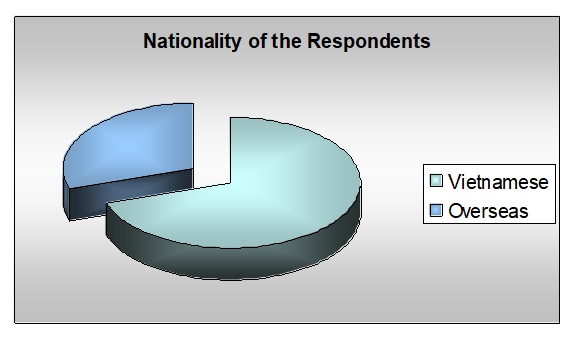
The Highest Education Level of the Interviewees
This general question has asked to the respondents with the intention to know the number and frequency of people who have done their higher educational degrees. The survey has indicated that 20% people done their intermediate-studies, 30% people achieved university degrees, 30% received a diploma, 10% people achieved a PhD, and 20% people got other degrees.
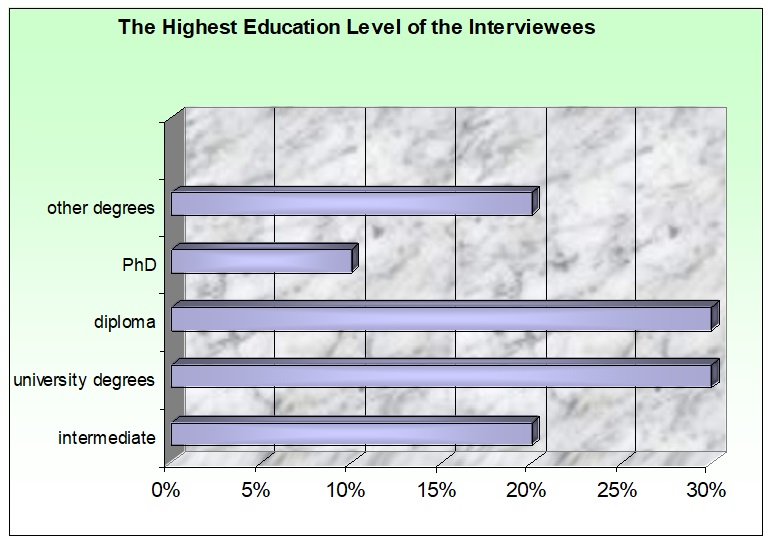
The job position of the interviewees
This question has kept forward to the respondents with the aim to recognize the presence of the interviewees working in diverse job positions. A good understanding of the job position will assist the research work by discovering the dependable opinions. Consequently, the researcher tried to focus on 25% financial managers, 20% accountants, 15% advisers, 25% bankers, and 15% other professionals.

Years of experience of the Respondents
Finding out the experience altitude of the respondents is imperative in the appraisal procedure of the results as it assists to discover the most precise and dependable answers. Among all the respondents, 50% people had an experience of less than 5 years, 30% respondents had experience between 5 and 10 years, and 20% had experience for more than 15 years.
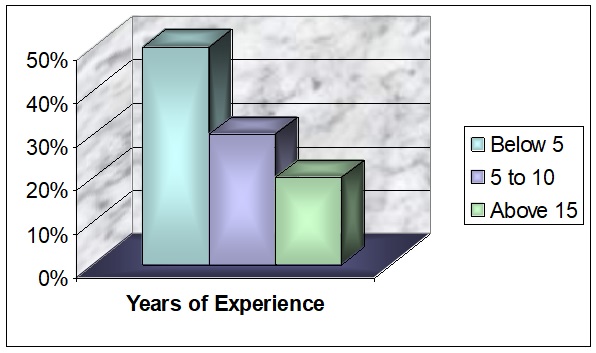
Whether Interviewees Have Clear Idea about Corporate Governance in Vietnam
All respondents have provided a positive feedback as response to this question.
Respondent’s View
Whether the Respondents Think That Existing Rules or Discloser Requirement Developed Due To Social, Political, and Economical Factors
The researcher tried to find out what the respondents think about the existing rules or discloser requirements and its connection with the social, political, and economical factors. There have been various reactions to this question. However, the largest proportion of the surveyed population has indicated that the social, political, and economical factors are one of the development tools. Amongst the total population, 35% interviewees agreed, 25% strongly agreed, 5% stayed neutral, 20% disagreed, whereas 15% strongly disagreed to the argument.
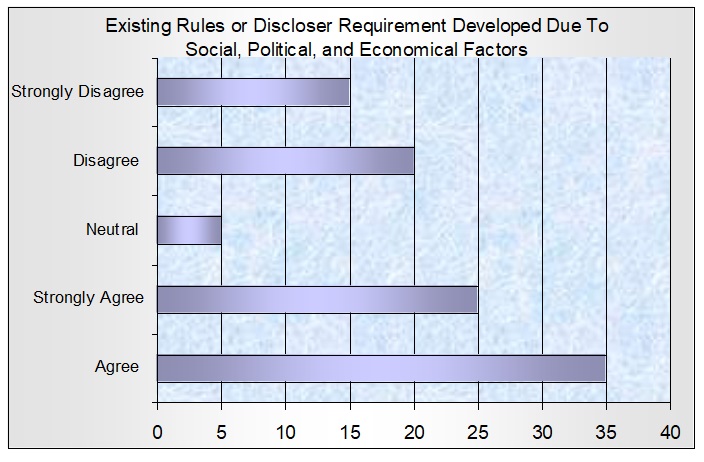
Result: The figure above shows that the social, political, and economic impacts are one of the development paraphernalia of the listing rules or discloser requirements, as indicated by the majority of respondents.
Extent to which Nike in Vietnam Conduct External and Internal Audits and Publish Their Reporting Publicly
Out of 40 interviewees, 40% respondents argued that Nike conducts external and internal audit and publish their reporting publicly by agreeing with this point, whereas 20% strongly agreed with this. Conversely, about 5% people remained neutral and 25% people disagreed to this point. Most interestingly, about 10% people have strongly disagreed to this proposed statement.
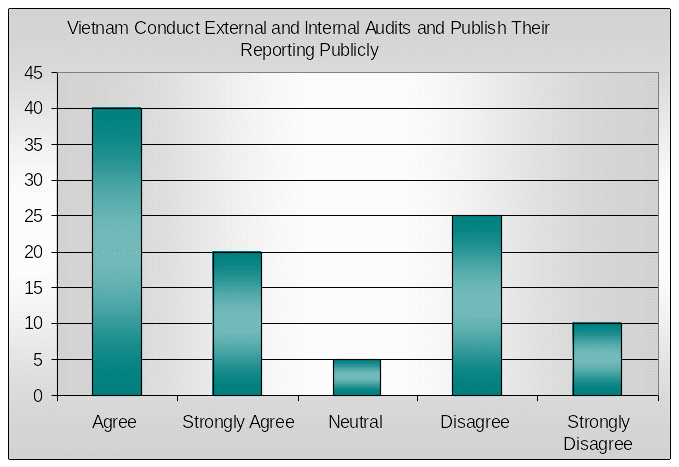
Result: It has noticed that even though a substantial number of people have disagreed to the question of the researcher, the largest proportion thinks the statement to be true.
Do Existing CG System Would Play Sufficient Role to Protect Corporate Fraud in Financial Reporting
About 35% respondents believe that existing CG system would play sufficient role to protect corporate fraud in financial reporting as they have agreed to this point. On the other hand, 15% people have strongly disagreed to this, whereas about 10% people have seen to stay neutral. However, 25% respondents think that the existing CG system is not adequate, as they need to further modification. With the same point of view, 15% people have strongly disagreed to the proposed question.
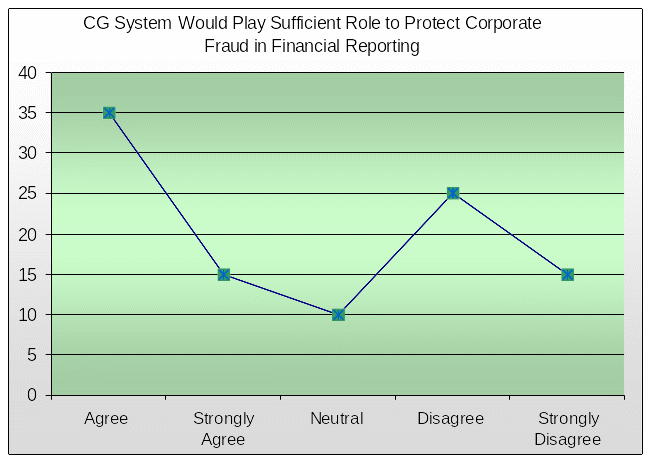
Result: The result shows the fact that a good percentage of the interviewees think the existing system to be adequate, whereas still a quite large percentage thinks that the CG system need further development.
Whether the Respondents Think That Nike Followed Code of Conduct to Ensure Shareholders’ Right
Amongst the total number of interviewees, the largest percentage thinks that Nike followed code of conduct to ensure shareholders’ right. Approximately 45% people has agreed to this statement, 35% people has strongly agreed to this statement, where as 5% have not given any response. On the other hand, although 15% people disagreed to this argument, none of them has strongly disagreed to this.
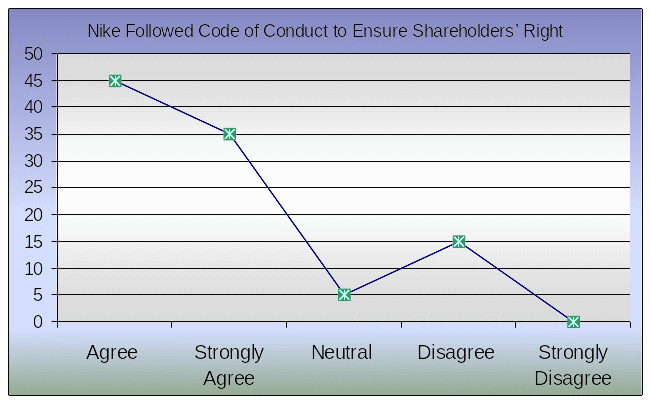
Result: The respondents specially pointed out the importance of code of conduct to ensure shareholders’ right and most went on to state that Nike tries to follow this in every stages of its operations.
Whether the Respondents Believe That Existing CG Would Reduce Conflicts of Interest
The feedbacks received from this question have been a mix reaction from the side of the respondents. Many of them have argued in favour or in disfavour, that existing CG would reduce conflicts of interest. Amongst 40 respondents, 35% people stated that they believe the existing CG to reduce conflicts of interest, where as 30% people have strongly agreed to this. Conversely, 5 percent chose not commenting anything to this, whilst 25 percent people disagreed, and the rest 5% have strongly disagreed to this.
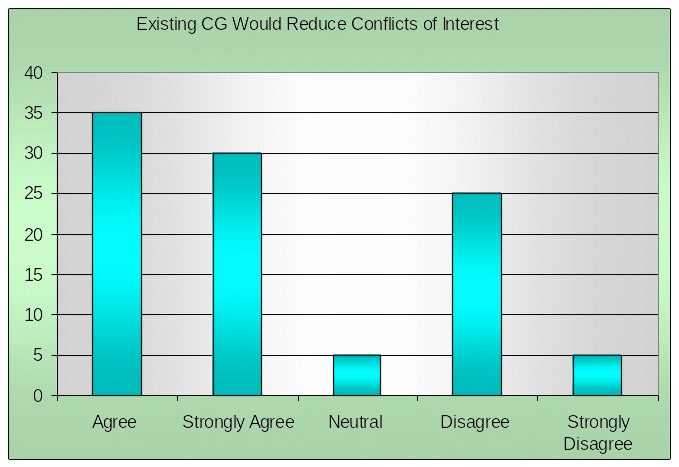
Result: In majority of cases, a trend has observed where most of the respondents have argued that the existing CG reduces conflicts of interest. However, the figure demonstrates the facts that still a few percentage of the population have disagreed to this matter.
Question 12: Do the Respondents Think That Nike in Vietnam Promote Transparency and Accountability with the Employees, Supplies, Banks and Other Stakeholders–
About 35 percent people have agreed that Nike in Vietnam promotes transparency and accountability with the employees, supplies, banks and other stakeholders, whilst about 50 percent have strongly agreed to this statement. Conversely, 10 percent people have stayed neutral, whereas 5 percent have disagreed to this. However, none of them has strongly disagreed to this fact.
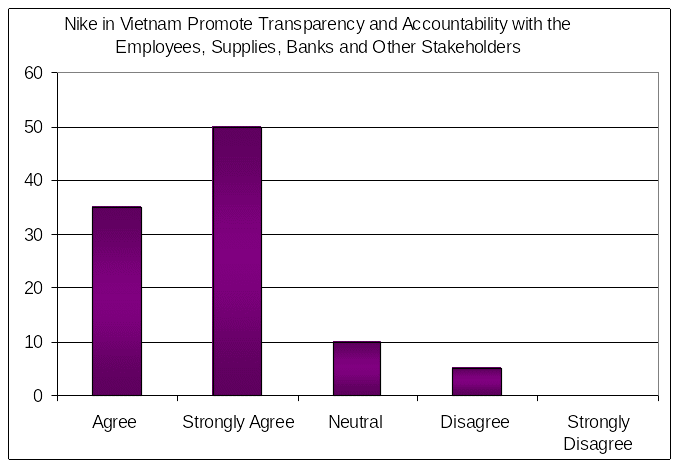
Result: It has clearly noted that in most of the circumstances, the respondent group went on to pursue that Nike in Vietnam promote transparency and accountability with the employees, supplies, banks and other stakeholders. This has represented in the figure above.
Whether Stakeholders Would Play Their Role Perfectly Under Existing CG Would Reduce Conflicts of Interest or Not
There has been a mixed reaction this question. Around 25% people has agreed to the matter, where as 20% has strongly agreed to his. On the other hand, 10 people have not commented anything on this and 15% have disagreed to this. However, 30 percent people have strongly disagreed to this matter.
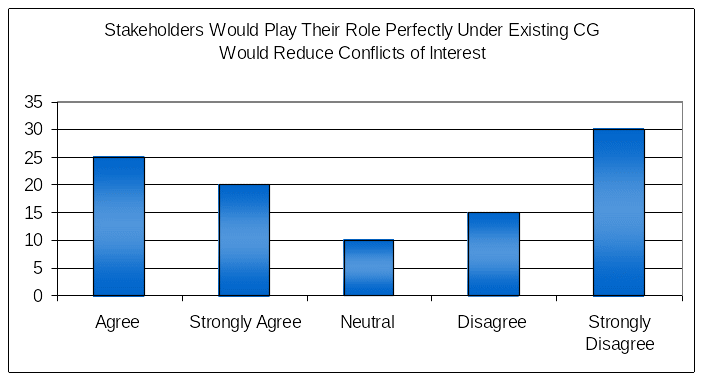
Result: It is arguable that although a good numbers of the interviewees believe that stakeholders would play their role perfectly under existing cg would reduce conflicts of interest, the significant part of them have suggested the matter from a different point of view.
Does the Board of Detectors Decision-Making Process Comply With the Law on Enterprise 2005
Most of the respondents have argued positively to this proposed question. About 35% have agreed that the board of detectors decision-making process comply with the law on enterprise 2005, whereas 40% people have strongly agreed to this. Nevertheless, 20% people have stayed neutral. In context, 5% have disagreed to this statement, whilst none of them has strongly disagreed.
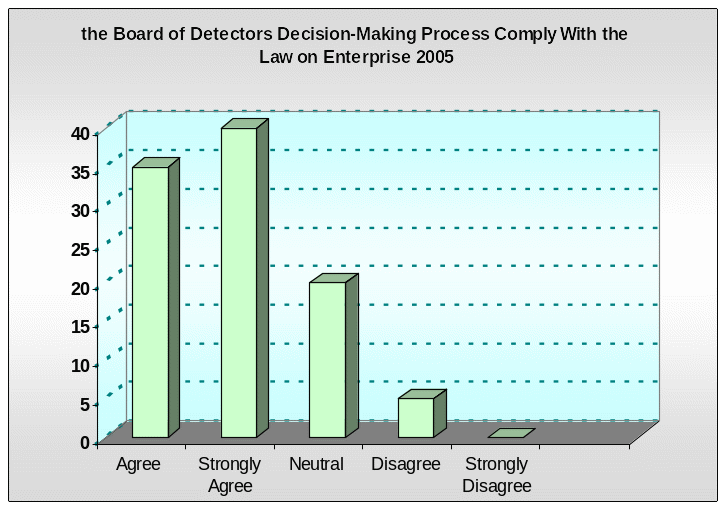
Result: Although it is widely believed by the people that the board of detectors decision-making process comply with the law on enterprise 2005, there are some chances of there statements to be biased.
Whether Nike Followed International Standards of Corporate Governance in Vietnam or Not
This question has intended to assess whether or not the interviewees believe that Nike followed international standards of corporate governance in Vietnam. As per the survey suggests, 35 percent of the surveyed respondents have argued that they agree. On the other hand, 40 percent people have stated that they strongly agree to this question, where as 15 people were neutral. In context, 10 percent respondents have disagreed to this and the rest 5 percent said they strongly disagree to any such concern.
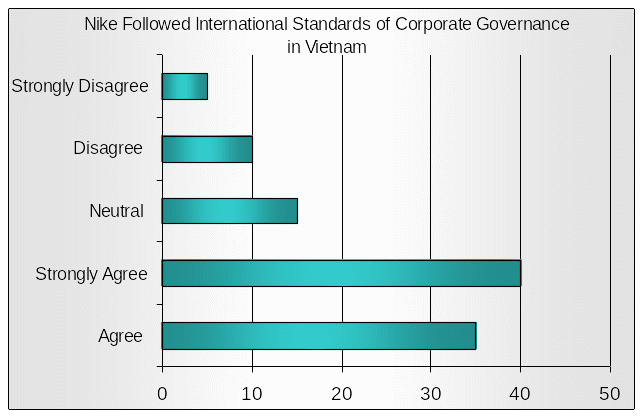
Result: It is clearly visible from the figure above that the majority of the surveyed populace believes that Nike followed international standards of corporate governance in Vietnam.
Whether the CG System in Vietnam Should Include Severe Punishment for Non-Compliance of CG Rules or Not
It is important to note that about 45 percent of the surveyed interviewees have agreed to the fact that the CG system in Vietnam should include severe punishment for non-compliance of CG rules. Similarly, 25 percent of these people have strongly agreed to this statement, where as, at the same time, 5% people has described their neutral position to answer this question. On the other hand, about 20 people have disagreed and 5 percent respondent argued that they strongly disagree in this point of statement.
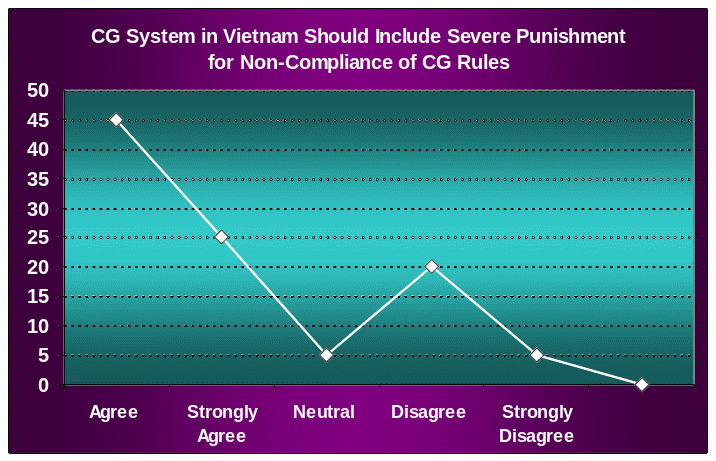
Result: Indeed, the largest proportion of the interviewees believes the CG system in Vietnam should include severe punishment for non-compliance of CG rules. This has demonstrated in the figure, where it has seen that the number of respondents appreciating this is higher in number.
Whether the Respondents Think That Nike in Vietnam Maintains the Vietnamese Labour Code -2002 with Ethical Standard
In the middle of 40 respondents, 30 percent of the surveyed populace agreed that Nike in Vietnam maintains the Vietnamese labour code -2002 with ethical standard. On the other hand, 45 percent people strongly agreed to this concern, where as 15 percent people stayed neutral. In addition, 10 percent of the population has seen to have disagreeing to this statement, whilst none has strongly disagreed to the proposed statement.
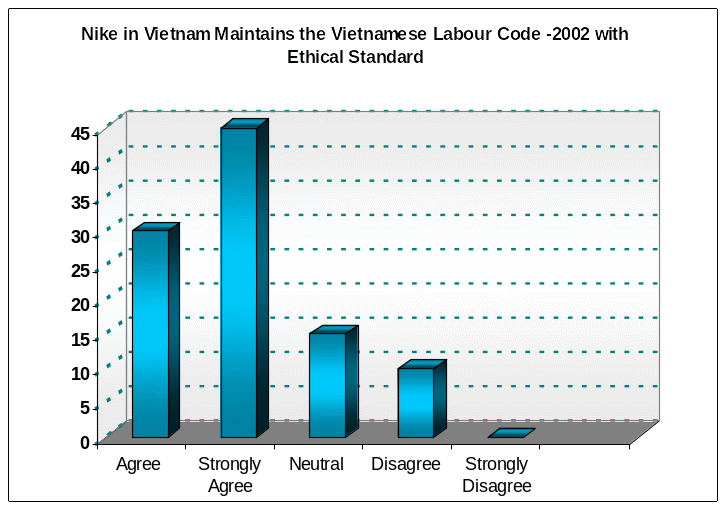
Result: The result shows the fact that majority of the population believes that Nike in Vietnam maintains the Vietnamese labour code -2002 with ethical standard.
Whether Nike in Vietnam Conduct Any Monitoring and Supervisory Role at Its Factories for Corporate Governance or Not
The survey suggested the fact that about 35 percent of the surveyed population agreed with the fact that Nike in Vietnam conduct monitoring and supervisory role at its factories for corporate governance. Conversely, the percentage of people who strongly agreed to this statement was about 30 percent, whereas merely 5 percent people stayed neutral. On the other hand, 20 percent of the respondents disagreed, whilst 10 percent people strongly disagreed to the proposed statement.
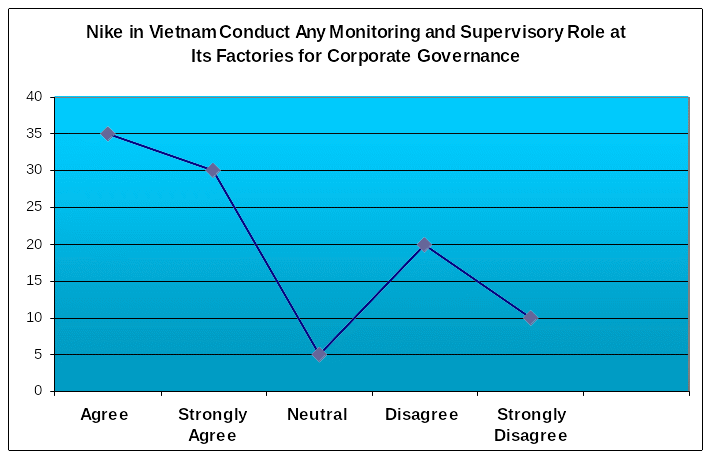
Result: It has a widely accepted that Nike in Vietnam conduct monitoring and supervisory role at its factories for corporate governance.
To What Extent the Respondents Believe That Existing Rules of CG in Vietnam Need Further Modification for Future Development
It is essential to note that amongst 40 respondents, about 25 percent of the interviewees agreed with the fact. In a similar way, it has noticed that 40 percent of the respondents have strongly agreed to this, where as none have stayed neutral. On the other hand, 25 percent peopled disagreed, while the rest 10 percent said they strongly disagree to this assertion.
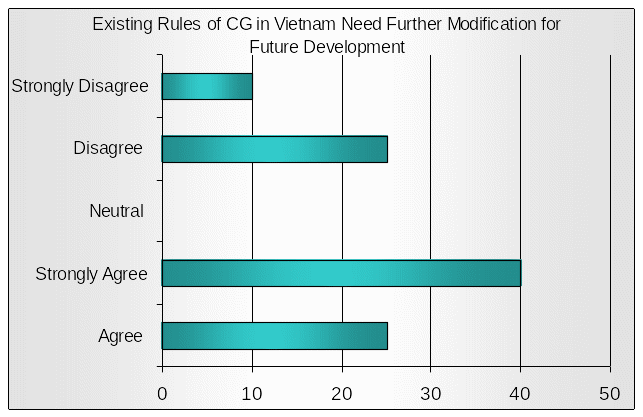
Result: The result shows the fact that the majority of the surveyed population agree that existing rules of CG in Vietnam need further modification for future development.
Discussion
Challenges of the corporate governance in Vietnam
It has evidenced that the prevailing legislation for the corporate governance system in Vietnam is the ‘Law on Enterprises – 2005’ and it is the main resources of existing governance for the business community of Vietnam but the underlying dilemma is that there are other several laws exists in the practice those may conflict with the core principals of this legislation. Minh and Walker (2008) argued that the foremost troubles of smooth practice of corporate governance system in Vietnam are commencing due to lack of confidence on subordinate legislations those may lead the organizations towards inefficiency, hindrance to free flow of business operation and lacking of judicial transparency. The National Assembly has enacted the Law on Enterprises – 2005 with the vision to introduce a governance system comparable with the western countries but there are huge subordinate laws those influence all over the governance system of the country and it has considered as a challenge for corporate governance rules in Vietnam.
Rather than the Law on Enterprises – 2005, there is some unavoidable legislation, which is essential to practice for the governance system among them the Vietnamese Labor Code -2002 is the most influential for all organizations. For special purpose and for the financial institutes, insurance companies, business with securities and auditing required following Law on Credit Organization – 1997, Securities – Law 2006, Law of Insurance Business – 2000, and Law of Accounting – 2003, in real life practice it is burdensome for the companies to comply all such legislation where there identified conflicting nature of practice. For instance, Law of Securities – 2006 has made it clear that all the companies in Vietnam would administered with Law on Enterprises – 2005 but it has adopted unavoidable condition for the listing companies to ensure transparency through discloser of annual reporting to the publicly which is not a part of Law on Enterprises – 2005.
Corporate Governance for the Listed Companies in Vietnam
Minh and Walker (2008) added that the legislation has made it compulsory for the listed companies in Vietnam to follow Law of Securities – 2006 and Law of Accounting – 2003 that provide guiding principal about the securities regulator and standard of accounting and auditing in Vietnam. It is essential for the companies to get prior approvals from the stock exchange regulatory authority for the trading their issues in the stock exchanges. In consideration of time length, the Vietnamese stock exchanges are very young and there is enough limitation to develop the market in accordance with the appropriate governance structure for the listed companies. Under the Law of Accounting – 2003, the auditing and accounting principles of Vietnam have a vital a role to enhance the practice of regulatory framework for CG in Vietnam while it has regarded to engage professional of accountant and auditor for internal and external observation along with the guideline provided by the Ministry of Finance.
In Vietnam, there are few professional Accounting firms already developed along with their association but due to absence of particular accounting standards in the country, the accountants are practicing a mixed process of reporting that they are familiar. Though the Ministry of finance has provided some basic standards for accounting and auditing, most of the professional accountants and auditors are not complying with those standards, but come into practice with there own choice while most of their current practice does not comply with the global standard of accounting and audit and driving towards relatively trivial role of practice.
OECD Principles and Corporate Governance in Vietnam
The World Bank (2006) argued that various countries follow the corporate governance standards and codes of conduct determined by the guidelines of different international agencies while the wider parts of prevailing countries follow the OECD’s guideline of practice and it would be most significant for Vietnam to espouse with the OECD principles with the aim to quick improvement socio-economic infrastructure. Dan (2005) added that the most recent OECD publication for the Principles of Corporate Governance has released in 2004 with huge rejoinder of previous guideline with a variety of options of working with corporate governance with the practicing experiences in the developed countries. The CG practice and principals of OECD has already supported and prescribed for the Asian emerging economy by the international agencies like IMF (International Monetary Fund) and World Bank and it is notable that the World Banks has already assessed the corporate governance status of Vietnam with OECD principals.
Minh and Walker (2008) explained that in accordance with the principles OECD it is essential for Vietnam bring into practice of evaluating and improving the legal system, institutional improvement and enhancing the regulatory configuration aimed to deliver excellent corporate governance while the ultimate objectives faced to the significant development of stock market. Due to newly established stock exchanges, the Vietnamese regulatory authorities are keen to integrate OECD guidance to achieve quick trust of the corporations and investors while the broader areas of corporate governance in Vietnam has restructured with the principals as –
- Introduction to an effectual and standardized framework for the corporate governance practice in Vietnam,
- In accordance with the principles of the OECD the corporate governance practice in Vietnam has already pointed out the rights and powers of the members and shareholders integrating with the board and Chairperson, General Director and CEO;
- Complying with the guideline of the OECD, the corporate governance practice in Vietnam has ensured equitable treatment of shareholders and members;
- Vietnamese Corporate governance under the Law on Enterprises – 2005 has confirmed the role of stakeholders in corporate governance and the responsibilities of the board
- Vietnamese Corporate governance under the Law of Securities – 2006 and Law of Accounting – 2003 has ensured the disclosure, transparency; and accountability.
It has been suggested that the guiding principal of OECD has generated to administering the listed companies, Vietnam may take further modification to take all other companies in a same harmonized system of corporate governance.
Conclusion
Recommendation
Currently, Vietnam does not enclose any comprehensive corporate directive that can apply for all sorts of businesses, and the reality reveals that besides of common conventions, Vietnam also sets out basic laws to oversee each kind of business; therefore, there still exist differences in conventions about “corporate governance” and the enforcement of corporate governance for every businesses aggregately. In this context, modernization of bureaucratic levels that carry out the execution of regulations at different stages including the enforcement level should be ensured, giving particular care to specialized skills; moreover, in Civil Laws, the concerned officials should have more power in investigation, prosecution, and proceedings and they should have to reach a specified professional knowledge through training-courses on CG.
The nation needs to focus on building strict and justified legislations on the corporate practices within the country; in doing so, the most essential thing is to make all the legal instruments compatible with each other, as in Vietnam, a key concern is the present legal-scaffold, which conflict with a range of other legal-instruments. Such problems lead to a number of complications in performance of the corporations; in addition, a huge amount of time has needed to flatten such complications if the country in fact desires to put together a comprehensive lawful-framework. Emphasizing on the market for corporate control is one of the foremost issues in developing CG; therefore, Vietnam should focus on enhancing the market for mergers and acquisitions that may assist advancing CG, as it is a legal-framework to regulate listed corporations in highly centralized markets; additionally, the government should reassess the Enterprise Laws and standardize them with global conventions.
On the other hand, Nike needs to focus a number of factors in order to ensure its compliance with the corporate governance and ethical operational practices. There has been an increasing controversy, which suggested Nike’s unethical practices in terms of labor exploitation and abusive treatment towards the Vietnamese workers. It is important to note that in stating whether Nike maintains the Vietnamese Labor Code -2002 with ethical standard, although most of the respondents from the top management were mostly arguing in favor of the organization, a few of them still disagreed. In order to ensure a long-term and successful business operation in Vietnam with proper ethical conduct, the company should comply broadly with the concerned legislations.
Moreover, in providing feedback as to whether Nike’s existing rules of corporate governance in Vietnam needs further modification for future development, about 65 percent respondent from the top managerial position of the sub contractors commented in favor. It is important to state that in the rapidly changing pace of globalization and the concern for preserving the interest of the shareholders and upholding the rights of the Vietnamese communities spontaneously with continuous development of international corporate laws and regulations, it is significant that the MNC’s CG practices should be further updated in relation to altering conventions. The existing rule should therefore improve more transparency level by strengthening internal controls, recruiting independent supervisory body, external audits founded on global standards, disclosing any financial assistance from the nation, and generating collective performance reports; as in some cases, existing discloser rule serves the interest of particular groups (e.g. director’s remuneration is a most controversial issue).
As per the conducted survey, although the substantial number of respondents argued that Nike follows international standards of CG in Vietnam, there has been still many of them who argued in disfavor of this statement. In this context, the company needs to have a close observance to its corporate governance standards to make sure that it complies perfectly with its internal rules in order to operate with the international standards in Vietnam. In so doing, Nike needs impose additional emphasize by employing non-executive directors to ensure that the business in complying with its international standards and code of conduct throughout every segment of its operation in Vietnam.
Conclusion
The remarkable contribution of this research is that, it has illustrated the dare of multinational like Nike to violating local legislations of Vietnam for corporate governance, by presenting the larger scenario of developing the legislation for administering business organizations in Vietnam. Tough there is no sole corporate governance legislation in Vietnam, but with a set of legislation the corporate governance system of Vietnam has already well organized comparable to the US and UK corporate governance. For the case of Nike it has evidenced that multinational are reluctant to follow the prevailing legislations of corporate governance Vietnam while the FDI motivated Vietnamese regulatory authority and government overlook the multinationals such corporate scandal. It would be not wise to for the Vietnamese authority to show liberal attitude to the multinationals for their violation of corporate governance system, this is the proper time to controlling multinational; in Vietnam. It is essential to amend the existing by legislation by adding the provision of punishment of corporate managers for violating corporate governance system in Vietnam
Reference List
ACCV (2010) Organizations: Nike Vietnam LLC. Web.
Bhatnagar, D. & Rathore, A (2006) Nike in Vietnam: The Tae Kwang Vina Factory. Web.
Blomstrxom, M. & Kokko, A. (1998) Multinational Corporations And Spillovers. Journal Of Economic Surveys, 12(2). Web.
Boje, D. M. (2008) Nike: Freedom of Association and Collective Bargaining. Web.
Chivers, D. (2007) The Companies Act 2006: Directors’ Duties Guidance. Web.
Cohen, L., Manion, L. & Morrison, K. (2007) Research Methods in Education. 6th ed. New York: Routledge.
Cung, N. D. (2008) Corporate Governance In Vietnam: Regulations, Practices And Problems. Web.
Dan, B. T. (2005) Legal Issues of Enforcement For Corporate Governance In Vietnam: Constraints And Recommendations, Corporate Governance: A Global Perspective Advances in Financial Economics, 11(1): 95–108.
Davis, J. R. & Dzung, M. K. (2010) A practical insight to cross-border Corporate Governance: Vietnam. Web.
Gompers, P., Ishii, J. & Metrick, A. (2003) Corporate governance and equity prices. The Quarterly Journal of Economics, 107-155.
Gower, L.C.B, & Davies, P.L. (2007) Principles of Modern Company Law. 8th ed. London: Sweet & Maxwell.
Hai, B. X. (2006) Vietnamese Company Law: The Development and Corporate Governance Issues. Web.
Locker, R. et al (2007) Beyond corporate codes of conduct: Work organization and labor standards at Nike’s suppliers. Web.
Locke, R. Qin, F. & Brause, A (2006) Does Monitoring Improve Labor Standards? Lessons from Nike. Web.
Lowry, J. & Dignam, A. (2007) Company Law. 4th edition. London: Oxford University Press.
Malhotra, N. K. (2009) Marketing Research- An Applied Orientation. 5th ed. Prentice-Hall of India Private Limited.
Minh, N. T. (2006) Highlights of The New Investment and Company Laws of Vietnam. Web.
Minh, T. L. & Walker, G. (2008) Corporate Governance of Listed Companies in Vietnam. Web.
Monks, A. G. & Minow N. (2007) Corporate Governance. 4th ed. London: Wiley-Blackwell Publishing.
National Assembly (2003) Labor Code of Socialist Republic of Vietnam. Web.
National Assembly (2005) Law on Enterprises. Web.
Nguyen, H.T.T. Minda, A. & Kechidi, M. (2010) Export-platform foreign direct investment as a strategic behaviour of multinational Firms: the case of Vietnam. Web.
Nguyen, T. (2004) Nike In Vietnam: an eyewitness account. Web.
Nike (2010) Annual report 2010. Web.
Nike (2011) Corporate Governance Guidelines. Web.
OECD (2004) Principles of Corporate Governance. Web.
Oman, C. Fries, S. & Buiter, W. (2003) Corporate Governance in Developing, Transition and Emerging–Market Economies. Web.
Parker, S. et al (2006) The Impact of The U.S.-Vietnam Bilateral Trade Agreement on Overall and U.S. Foreign Direct Investment In Vietnam. Web.
Saunders, M., Thornhill, A. & Lewis., P. (2006) Research Methods for Business Students. 4th ed. London: FT Prentice Hall.
Sekaran, U. (2006) Research Method for Business. 4th ed. London: John Wiley & Sons, Inc.
The World Bank (2006) Corporate Governance Country Assessment Vietnam. [pdf] Web.
Trinh, P. T. (2010) Relationship between Corporate Governance and Firm Performance in Vietnam. Netherlands: Maastricht School of Management.
Undén, C. (2007) Multinational Corporations, and Spillovers in Vietnam – Adding Corporate Social Responsibility. [pdf] Web.
Zikmund, W. M. (2006) Business Research Methods. 7th ed. Orlando: Harcourt Publishers.
Questionnaire
Part A
- Your name : _____________________________
- Address : _____________________________
- Phone : ______________________________
- Please select your nationality:
- Vietnamese
- Other
- Please select your highest education level
- Intermediat
- University degree
- Diploma
- PhD
- Other
- Please select your job position –
- Financial Manager
- Accountant
- Adviser
- Bankers
- Other
- Please mention your Years of experience:
- Under five years
- between five and ten years
- More than Fifteen years
- Do you have clear idea about Corporate Governance in Vietnam?
- Yes
- No
- No Comments
Part B
Please state to the level you agree or disagree with the following statements:
- To what extent you agree that existing rules or discloser requirement developed due to social, political and economical factors.
- [Agree]
- [Strongly Agree]
- [Neutral]
- [Disagree]
- [Strongly Disagree]
- To what extent Nike in Vietnam conduct external and internal audits and publish their reporting publicly?
- [Agree]
- [Strongly Agree]
- [Neutral]
- [Disagree]
- [Strongly Disagree]
- To what extent you agree that existing CG system would play sufficient role to protect corporate fraud in financial reporting.
- [Agree]
- [Strongly Agree]
- [Neutral]
- [Disagree]
- [Strongly Disagree]
- To what extent you agree that Nike followed code of conduct to ensure shareholders’ right.
- [Agree]
- [Strongly Agree]
- [Neutral]
- [Disagree]
- [Strongly Disagree]
- To what extent you agree that existing CG would reduce conflicts of interest.
- [Agree]
- [Strongly Agree]
- [Neutral]
- [Disagree]
- [Strongly Disagree]
- To what extent you agree that Nike in Vietnam promote transparency and accountability with the employees, supplies, banks and other stakeholders.
- [Agree]
- [Strongly Agree]
- [Neutral]
- [Disagree]
- [Strongly Disagree]
- To what extent you agree that stakeholders would play role their role perfectly under existing CG would reduce conflicts of interest.
- [Agree]
- [Strongly Agree]
- [Neutral]
- [Disagree]
- [Strongly Disagree]
- At Nike Factories in Vietnam, does the Board of Detectors decision-making process comply with the Law on Enterprise 2005?
- [Agree]
- [Strongly Agree]
- [Neutral]
- [Disagree]
- [Strongly Disagree]
- To what extent you believe that Nike followed international standards of CG in Vietnam.
- [Agree]
- Strongly Agree]
- [Neutral]
- [Disagree]
- [Strongly Disagree]
- To what extent you agree that CG system in Vietnam should include severe punishment for non-compliance of CG rules.
- [Agree]
- [Strongly Agree]
- [Neutral]
- [Disagree]
- [Strongly Disagree]
- To what extent you agree that Nike in Vietnam maintains the Vietnamese Labor Code -2002 with ethical standard.
- [Agree]
- [Strongly Agree]
- [Neutral]
- [Disagree]
- [Strongly Disagree]
- To what extent you agree that Nike in Vietnam conduct any monitoring and supervisory role at its factories for corporate governance?
- [Agree]
- [Strongly Agree]
- [Neutral]
- [Disagree]
- [Strongly Disagree]
- To what extent you agree that existing rules of CG in Vietnam need further modification for future development.
- [Agree]
- [Strongly Agree]
- [Neutral]
- [Disagree]
- [Strongly Disagree]